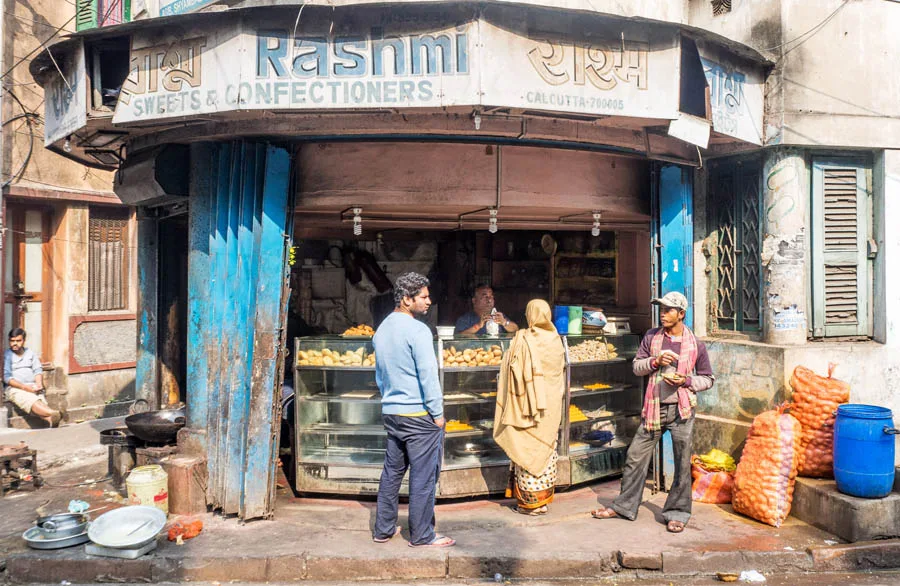The streets of Kolkata are famed as the mecca of India’s confectionery realm. For centuries, West Bengal’s capital city has witnessed the creations of various culinary sweets that have delighted countless palates. Of these, a 160-year-old dessert known as Lady Kenny or ledikeni, a light reddish-brown sweet ball beloved by locals and named after an Englishwoman, stands out with its unusual backstory. Let’s get to know it.
Courtesy of Ramsha Zubairi
What Is Ledikeni
Ledikeni is a Bengali mishti, or sweet, that can perhaps be considered the cousin to another local famous delicacy called pantau, or the more well-known Indian sweet, gulab jamun. It is prepared by kneading a mixture of chhena or split milk with a little flour to make small balls stuffed with either raw sugar, jaggery (gur), or mimosa sugar balls (nakuldana).
Once ready, these balls are then fried until golden brown and soaked in sugar syrup as the last step. The crispy outer surface transforms into a soft juicy texture as the sweet syrup fills the mouth upon consumption. Unlike its current small size, this dessert was once made large enough to be cut into smaller slices and served.
The Origins of Ledikeni
Back in the 19th century, the British colonial Bengal witnessed not just a social reform but also one in the culinary practices of its confectioners. It was a period of experimentation and invention, when sweet makers including Bhim Chandra Nag, N.C. Das, and others transformed the Bengali dessert menu with their creations. The need to serve an affluent and growing urban middle class led to the switch from khoya, an evaporated milk solid commonly used in Indian sweets, to chhena, or fresh curd cheese, as one of the main ingredients in their desserts.

A Bengali sweets shop. Photo courtesy of Flickr/Giridhar Yasa.
“The prevalent explanation of why Bengali sweet makers use chhena instead of khoya as the main ingredient,” says Colleen Taylor Sen, author of The Bloomsbury Handbook of Indian Cuisine, “is that they were influenced by the Portuguese, who settled in Bengal in the late 16th century and made cheese by separating curds from milk.” But the author further explains that the use of the ingredient goes back to at least 12th century India. “The 12th century cookbook The Manasollasa contains descriptions of sweet dishes made with chhena mixed with sugar, made into small balls and fried. So there are two stories.”
Bhim Chandra Nag, a renowned confectioner of his time, invented a chhena-based and syrupy dessert for Lady Charlotte Canning, the Vicereine and wife of the first Viceroy of India, Lord Charles John Canning. Though the exact period of its creation remains unknown, food historians generally accept it was conceived somewhere between 1858 and November 1861, the death of the Vicereine. But why was the ledikeni created?

Lady Charlotte Canning. Courtesy of Wikimedia Commons.
Various tales surround the birth of ledikeni. According to one, the Bengali mishti was created after the confectioner Nag had the idea to prepare a delicacy to commemorate Lady Canning’s birthday.
“Another version of the story,” says Sen, “is that after the Sepoy Mutiny/First War of Independence of 1857, sweet makers in the Bengali city of Berhampore prepared a special sweet to honor Lady Canning, who was supposedly touring with her husband, the Viceroy.” She adds, “However, this sounds rather improbable to me.”
Yet another legend narrates that not long after the Sepoy Mutiny, while on a visit to Calcutta in 1858, it was the Vicereine herself who asked Bhim Nag to prepare a special sweet for the occasion of her birthday. At the time, the confectioner was one of the most sought-after sweet makers among the aristocrats.
While each of ledikeni’s origin stories suggests a different motive behind its creation, there remains the question of whether the famous British lady ever took a bite of the confection created in her honor. Throughout her time in colonial India, Lady Canning penned many letters to her mentor and the then-ruler of the United Kingdom, Queen Victoria. However, none of the missives mention or discuss this particular dessert. Despite these uncertainties, several historians continue to claim that “Lady Kenny” became her favorite dessert, and she enjoyed it on every special occasion.
Unfortunately, not long after her arrival in India, Lady Canning passed away in November 1861 after contracting malaria and was buried in Barrackpore, a city and municipality of north suburban Kolkata. Following her untimely death, the mishti that eventually came to be known as ledikeni (due to the Bengali dialect) found fame among the locals. The popularity of ledikeni aka Lady Kenny continues even today, making it an essential part of West Bengal’s culinary landscape. No festival or special occasion is deemed complete without it.

A sweets shop in Kolkata. Photo courtesy of Flickr/Mike Prince
Where to Try Ledikeni in Kolkata, West Bengal
It remains a must to try some ledikeni while in Kolkata. Here are two shops that will carry it.
Bhim Chandra Nag (5 Nirmal Chandra St., Bowbazaar; map)
The legendary shop founded in 1829 by Paran Chandra Nag is credited for inventing ledikeni, among many other delicacies. The almost 200-year-old iconic confectionery shop is still considered one of the best places in Kolkata for treating your sweet tooth.
Jashoda Mistanna Bhandar (50/1 S.N Banerjee Road, Kolkata; map)
Established in 1935 by Lt. Shankar Chandra Poddar, Jashoda Mistanna Bhandar is yet another iconic sweets shop in Kolkata. Besides ledikeni, the menu also includes other of its famed mishtis such as laal mishti doi (sweet curd), kora pak talshash, rabri, and dofali.
About the author: Ramsha Zubairi is a freelance writer. Her work has appeared in BBC, Smithsonian Magazine, The Juggernaut, Dwell, Atlas Obscura and more.
There has never been a better time to plan your next trip and make your Dream vacation a reality . Whether you've been dreaming of relaxing on a sun-kissed beach, exploring ancient cities, or embarking on an epic adventure, now is the perfect moment to make it happen.













